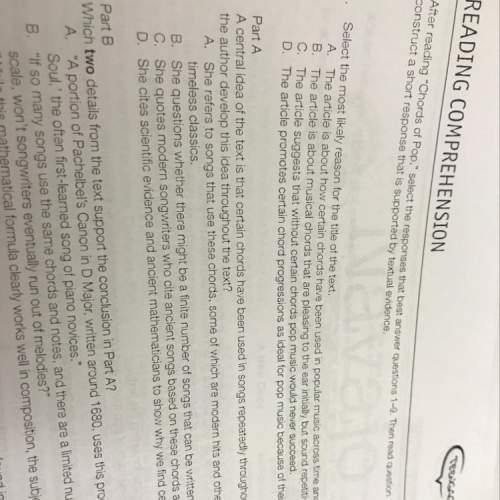Please and thank you for answering :)
Read the excerpts from the two articles on sea otters.
<...

Please and thank you for answering :)
Read the excerpts from the two articles on sea otters.
Article A
Sea otters live in the chilly Northern Pacific Ocean and spend almost all their lives in the water. They sleep, hunt, groom, mate, and give birth in the ocean, where they float on their backs on the water's surface. Adult sea otters spend more than a third of their day grooming their fur. This isn't for vanity; it's for survival. Unlike most sea mammals, sea otters do not have an inner layer of fat to protect them from the cold water. These creatures rely on their dense fur to protect them from the low temperatures. Sea otters have one of the thickest furs in all of the animal kingdom. An adult sea otter's coat can contain up to 1 billion individual hairs! These hairs form a protective, waterproof layer, which traps air and provides insulation. It is crucial that a sea otter's fur is kept clean to maintain this insulating layer between the water and their skin.
Article B
Oil spills from off-shore drilling and shipping are also an immense threat to sea otters. Sea otters are dependent on their thick fur to keep them warm. Its unique structure traps air that insulates their bodies from the cold water. When an otter's fur is covered in oil, it can no longer keep the otter warm. This can cause hypothermia and even death. If the otter tries to clean its fur, it will ingest the oil, which is poisonous. In 1989, the Exxon Valdez hit a reef in Alaska. The ship spilled over ten million gallons of oil into the ocean. The U. S. Fish and Wildlife Service believes that anywhere from 4,000 to 10,000 otters died due to this oil spill.
How are the authors' points of view different in these excerpts?
A. Article A focuses on the importance of the sea otter grooming its fur, but Article B shows that the sea otter's grooming habits endanger it when the water is not clean.
B. Article A explains that adult sea otters spend more than a third of their day grooming, but in Article B, the author explains that adults spend most of their day caring for their young.
C. Article A highlights the different reasons the sea otter's fur must be clean, and Article B highlights the actual process sea otters use to keep their thick coats clean and healthy.
D. Article A focuses on how the sea otter's fur can harm the animal, while Article B focuses on how the sea otter's fur can protect it from oil spills and other water pollution.

Answers: 3
Other questions on the subject: English

English, 21.06.2019 17:30, shadow29916
Does anyone know the answers to these two? i don’t want to have to guess, you!
Answers: 2

English, 22.06.2019 00:00, Jordan0423
What is the meaning of "full tide" as it is used in this sentence? before i could explain to her the differences of language in this world, she was embarked on the full tide of another subject. a long and involved argument an inaccurate representation a detailed and lively discussion an uncontrollable flood
Answers: 1

English, 22.06.2019 08:30, Thania3902
Make a story with words noodle saddle juggle riddle uncle throttle miracle muscle obstacle example
Answers: 2

English, 22.06.2019 11:30, jadeb124
Which sentence contains a punctuation error? a. have you met my great-aunt marie raines? b. my mother wrote three children's books about the family farm. c. my sister's mother in law lives with them, and everyone gets along fine. d. another hurricane is brewing in the mid-atlantic.
Answers: 1
Do you know the correct answer?
Questions in other subjects:

History, 26.11.2019 02:31

Mathematics, 26.11.2019 02:31



Mathematics, 26.11.2019 02:31


Mathematics, 26.11.2019 02:31



Mathematics, 26.11.2019 02:31







